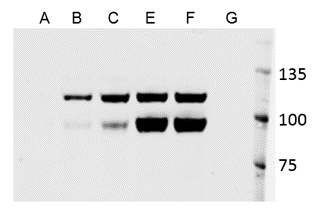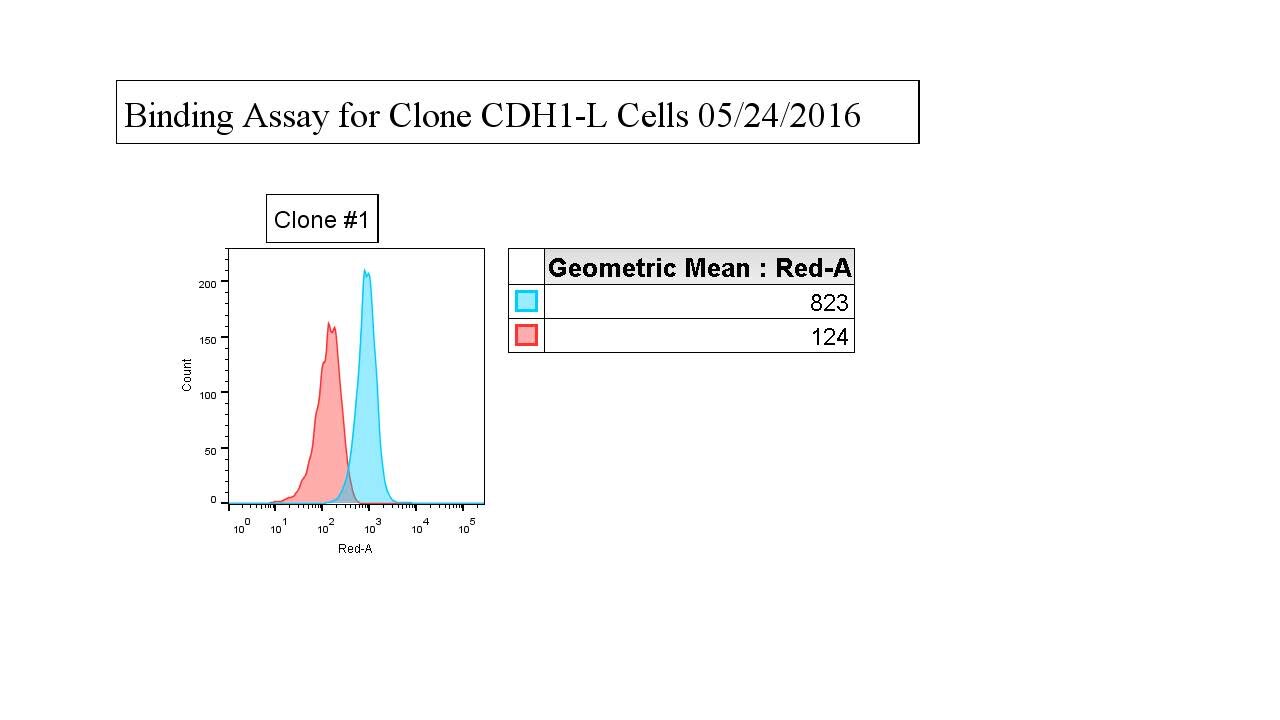Human E-Cadherin Antibody Summary
Asp155-Ile707
Accession # P12830
Applications
Please Note: Optimal dilutions should be determined by each laboratory for each application. General Protocols are available in the Technical Information section on our website.
Scientific Data
 View Larger
View Larger
Detection of Human E‑Cadherin by Western Blot. Western blot shows lysates of MCF-7 human breast cancer cell line, BT-20 human breast cancer cell line, and T47D human breast cancer cell line. PVDF membrane was probed with 2 µg/mL of Mouse Anti-Human E-Cadherin Monoclonal Antibody (Catalog # MAB18381) followed by HRP-conjugated Anti-Mouse IgG Secondary Antibody (Catalog # HAF018). A specific band was detected for E-Cadherin at approximately 120 kDa (as indicated). This experiment was conducted under reducing conditions and using Immunoblot Buffer Group 1.
 View Larger
View Larger
E‑Cadherin in MCF‑7 Human Cell Line. E-Cadherin was detected in immersion fixed MCF-7 human breast cancer cell line using Mouse Anti-Human E-Cadherin Monoclonal Antibody (Catalog # MAB18381) at 3 µg/mL for 3 hours at room temperature. Cells were stained using the NorthernLights™ 557-conjugated Anti-Mouse IgG Secondary Antibody (red; Catalog # NL007) and counterstained with DAPI (blue). Specific staining was localized to cell membrane. View our protocol for Fluorescent ICC Staining of Cells on Coverslips.
 View Larger
View Larger
E‑Cadherin in Human Stomach. E-Cadherin was detected in immersion fixed paraffin-embedded sections of human stomach using Mouse Anti-Human E-Cadherin Monoclonal Antibody (Catalog # MAB18381) at 5 µg/mL for 1 hour at room temperature followed by incubation with the Anti-Mouse IgG VisUCyte™ HRP Polymer Antibody (Catalog # VC001). Tissue was stained using DAB (brown) and counterstained with hematoxylin (blue). Specific staining was localized to plasma membrane. View our protocol for Chromogenic IHC Staining of Paraffin-embedded Tissue Sections.
 View Larger
View Larger
E‑Cadherin in Human Skin. E-Cadherin was detected in immersion fixed paraffin-embedded sections of human skin using Mouse Anti-Human E-Cadherin Monoclonal Antibody (Catalog # MAB18381) at 0.5 µg/mL for 1 hour at room temperature followed by incubation with the Anti-Mouse IgG VisUCyte™ HRP Polymer Antibody (Catalog # VC001). Tissue was stained using DAB (brown) and counterstained with hematoxylin (blue). Specific staining was localized to plasma membrane. View our protocol for Chromogenic IHC Staining of Paraffin-embedded Tissue Sections.
Reconstitution Calculator
Preparation and Storage
- 12 months from date of receipt, -20 to -70 °C as supplied.
- 1 month, 2 to 8 °C under sterile conditions after reconstitution.
- 6 months, -20 to -70 °C under sterile conditions after reconstitution.
Background: E-Cadherin
Epithelial (E)‑Cadherin (ECAD), also known as Cadherin-1, cell-CAM120/80 in the human, uvomorulin in the mouse, Arc-1 in the dog, and L-CAM in the chicken, is a member of the Cadherin family of cell adhesion molecules (gene name CDH1). Cadherins are calcium-dependent transmembrane proteins which bind to one another in a homophilic manner. On their cytoplasmic side, they associate with the three catenins, alpha, beta, and gamma (plakoglobin). This association links the cadherin protein to the cytoskeleton. Without association with the catenins, the cadherins are non-adhesive. Cadherins play a role in development, specifically in tissue formation. They may also help to maintain tissue architecture in the adult. E-Cadherin may also play a role in tumor development, as loss of E-Cadherin has been associated with tumor invasiveness. E-Cadherin is a classical cadherin molecule. Classical cadherins consist of a large extracellular domain which contains DXD and DXNDN repeats responsible for mediating calcium‑dependent adhesion, a single-pass transmembrane domain, and a short carboxy-terminal cytoplasmic domain responsible for interacting with the catenins. E‑Cadherin contains five extracellular calcium-binding domains of approximately 110 amino acids each (amino acids 155-697).
- Bussemakers, M.J.G. et al. (1993) Mol. Biol. Reports 17:123.
- Overduin, M. et al. (1995) Science 267:386.
- Takeichi, M. (1991) Science 251:1451.
Product Datasheets
Citations for Human E-Cadherin Antibody
R&D Systems personnel manually curate a database that contains references using R&D Systems products. The data collected includes not only links to publications in PubMed, but also provides information about sample types, species, and experimental conditions.
8
Citations: Showing 1 - 8
Filter your results:
Filter by:
-
Loss of polarity regulators initiates gasdermin-E-mediated pyroptosis in syncytiotrophoblasts
Authors: Khushali Patel, Jasmine Nguyen, Sumaiyah Shaha, Amy Brightwell, Wendy Duan, Ashley Zubkowski et al.
Life Science Alliance
-
Tracking Drug‐Induced Epithelial–Mesenchymal Transition in Breast Cancer by a Microfluidic Surface‐Enhanced Raman Spectroscopy Immunoassay
Authors: Zhen Zhang, Jing Wang, Karthik Balaji Shanmugasundaram, Belinda Yeo, Andreas Möller, Alain Wuethrich et al.
Small
-
EGFR activation-induced decreases in claudin1 promote MUC5AC expression and exacerbate asthma in mice
Authors: Z Jia, K Bao, P Wei, X Yu, Y Zhang, X Wang, X Wang, L Yao, L Li, P Wu, W Yuan, S Wang, J Zheng, Y Hua, M Hong
Mucosal Immunol, 2020-03-04;0(0):.
Species: Mouse
Sample Types: Cell Culture Lysates, Protein
Applications: ICC, Western Blot -
Semaphorin 3A induces mesenchymal-stem-like properties in human periodontal ligament cells.
Authors: Wada, Naohisa, Maeda, Hidefumi, Hasegawa, Daigaku, Gronthos, Stan, Bartold, Peter Ma, Menicanin, Danijela, Fujii, Shinsuke, Yoshida, Shinichi, Tomokiyo, Atsushi, Monnouchi, Satoshi, Akamine, Akifumi
Stem Cells Dev, 2014-02-10;23(18):2225-36.
Species: Human
Sample Types: Whole Cells
Applications: ICC -
Generation of glucose-responsive, insulin-producing cells from human umbilical cord blood-derived mesenchymal stem cells.
Authors: Prabakar K, Dominguez-Bendala J, Molano R, Pileggi A, Villate S, Ricordi C, Inverardi L
Cell Transplant, 2011-12-21;21(6):1321-39.
Species: Human
Sample Types: Whole Cells
Applications: ICC -
Gram-positive bacteria enhance HIV-1 susceptibility in Langerhans cells, but not in dendritic cells, via Toll-like receptor activation.
Authors: Ogawa Y, Kawamura T, Kimura T, Ito M, Blauvelt A, Shimada S
Blood, 2009-03-11;113(21):5157-66.
Species: Human
Sample Types: Whole Cells
Applications: Flow Cytometry -
Generation of pluripotent stem cells from adult human testis.
Authors: Conrad S, Renninger M, Hennenlotter J, Wiesner T, Just L, Bonin M, Aicher W, Buhring HJ, Mattheus U, Mack A, Wagner HJ, Minger S, Matzkies M, Reppel M, Hescheler J, Sievert KD, Stenzl A, Skutella T
Nature, 2008-10-08;456(7220):344-9.
Species: Human
Sample Types: Whole Cells
Applications: ICC -
Expression of mesenchyme-specific gene HMGA2 in squamous cell carcinomas of the oral cavity.
Authors: Miyazawa J, Mitoro A, Kawashiri S, Chada KK, Imai K
Cancer Res., 2004-03-15;64(6):2024-9.
Species: Human
Sample Types: Whole Tissue
Applications: IHC-P
FAQs
-
Why does the staining protocol with this Cadherin antibody use buffers containing Ca2+ and Mg2+?
The staining protocol with this and other Cadherin antibodies uses buffer containing Ca2+ and Mg2+ because Cadherin function is Calcium-dependent.
Reviews for Human E-Cadherin Antibody
Average Rating: 4 (Based on 3 Reviews)
Have you used Human E-Cadherin Antibody?
Submit a review and receive an Amazon gift card.
$25/€18/£15/$25CAN/¥75 Yuan/¥1250 Yen for a review with an image
$10/€7/£6/$10 CAD/¥70 Yuan/¥1110 Yen for a review without an image
Filter by:
Expression of E-cadherin in different breast cancer cell lines.





